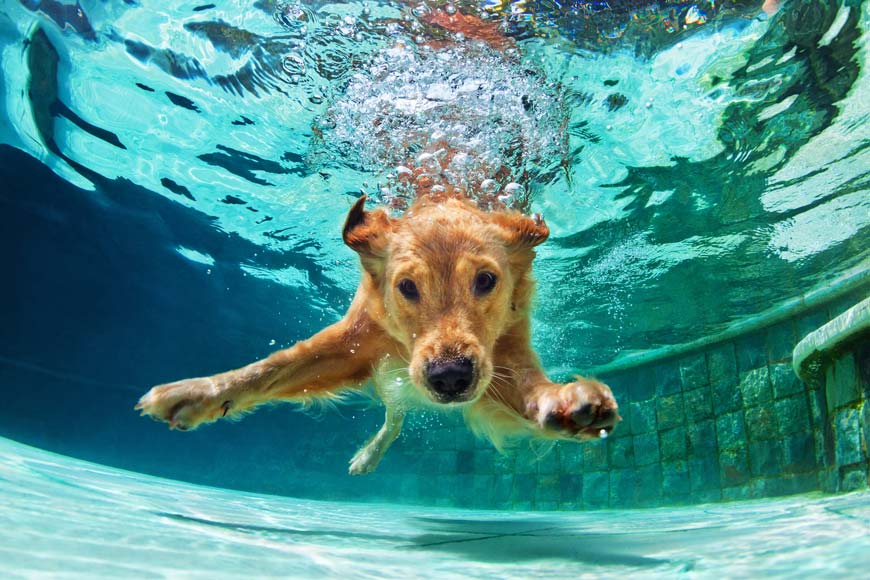How to Teach Your Dog to Swim

Many people with dogs wonder about teaching them to swim. Is swimming good for dogs, do they need to be taught how to do it, and how do you go about helping them learn?
Is It Good for Dogs to Swim?
Swimming is excellent exercise for humans and dogs. It's a great cardio workout and can help a dog lose weight, stay at a good weight, and remain or improve his fitness and health. It's also quite enjoyable for many dogs and allows people to get outside with their dog and enjoy fresh air and community.
Some dogs have a natural propensity for swimming. They have webbed feet and can swim for hours without getting tired of it. Others might be nervous or even scared of water, and their body structures might make it more difficult. Dogs with extremely flat faces might have a harder time swimming, as they may with other forms of exercise as well because they don't take in air as easily due to their shortened airways.
How to Teach a Dog to Swim
The first thing to do when considering swimming with your dog is take him to an area where the water is shallow, and it's easy to get in and out. A child's plastic swimming pool is great for this step. You can put a little water in it and show your dog how to get in and out by doing it yourself. You can observe how your dog acts around the water and determine whether he seems to be naturally inclined to swim or a little bit scared or hesitant.
If your dog is a little bit hesitant about getting into the pool, try tossing a toy he likes over the side into the water. When he steps over to chase the toy, give him lots of praise. If your dog is still hesitant to get into the water at that point, try climbing in yourself and giving him lots of encouragement to join you. You might even take an especially tasty treat in with you to lure him with. Always remember to be positive and give your dog praise at each step.
Once your dog is comfortable in the child's pool, you can practice in a bigger body of water. Make sure to choose a calm day when the water is not wavy, and don't choose a spot with active currents. It should also be shallow at the entry and easy to get in and out of.
If the water you choose to practice in is a public beach, make sure it's OK for dogs to be there before you arrive. Some beaches are marked as dog-free areas. Also, take a look at this article before you go to make sure you're prepared and know how to keep your dog safe and also be thoughtful of other beach-goers: "Beach Safety for Dogs."
Show your dog how to get into and out of the new body of water by doing it yourself. If your dog is slow to get used to or enjoy the water, go at his pace. You might need to come back several times before your dog goes in, for instance. Be prepared to be patient and stay positive. If you react with impatience or anger, it's likely to make your dog even more concerned about and reluctant to interact with the water.
Always check with your veterinarian before starting a new exercise regimen with your dog. Verify that he is healthy enough for the activity, and find out if there are any particular precautions you need to take.
Be playful with your dog while you're practicing being around and getting into and out of the water. Use games like a ball or flying disc to play on the shore or in the shallow surf. This can help a nervous dog loosen up and have more fun in the water. Toys that float are especially great for teaching a dog to swim and also to have lots of fun after he learns.
You can try a life jacket for dogs if you're concerned about his swimming ability or to help your dog get more comfortable in the water.
Most dogs naturally know how to move their feet and swim once they're in deep water. Stay close to your dog and give him encouragement while he's learning what he can do. Support the middle of his body for him at first until he learns the coordination necessary to move all four feet and stay afloat.
Get Help From a Strong Swimmer
One thing that can really go a long way toward helping a reluctant canine swimmer is to bring along another dog that loves to swim. Dogs can learn from each other, and when one dog sees his buddy out there swimming and having a blast in the water, it can help him get motivated and feel more confident getting out there too.
Don't Force a Reluctant Dog to Swim
One thing you should never do is take your dog to the end of a dock or pier and toss him into the water to teach him to swim. Doing so might be dangerous for him, and it is likely to cause extreme fear. It might permanently damage the bond between you and your dog, too, because his trust in you could be shaken.
Some dogs simply don't like water, and no matter how much time you spend attempting to get them comfortable with it, they dislike swimming. Don't get frustrated or punish your dog for disliking water. Simply find some other activity the two of you can enjoy doing together instead.
Other Concerns Regarding Dogs and Swimming
Dogs that swim a lot, especially those with floppy ears, can be prone to developing otitis externa, or outer ear canal infections. Before you take your dog swimming, talk with your veterinarian about whether an ear cleaning solution with a drying agent might be a good thing to use to clean your dog's ears after swims.
Dogs that swim in chlorinated pools might develop skin or eye problems as a result. Check with your veterinarian about whether your dog should routinely swim in a pool.
It's a good practice to get into to rinse your dog off with clean water after he's done swimming, whether in a pool or a natural body of water. That way, any bacteria, chlorine, waterfowl stool, or other substances that might have gotten onto him are rinsed off. Then, dry him thoroughly so water isn't left to sit next to his skin under his fur, where it might encourage a skin infection.
Don't let your dog drink out of standing water, and discourage him from drinking the water he's swimming in. This might be hard to do, but one way you can decrease his desire to drink the water is by bringing fresh water to the swimming area for him and encouraging him to drink it often. Bacteria and other substances in the swimming water could make your dog sick.
You May Also Like These Articles:
Is Giving Ice or Ice Water to Dogs Dangerous?
Otitis Externa: Ear Infections in Dogs
Disclaimer: This website is not intended to replace professional consultation, diagnosis, or treatment by a licensed veterinarian. If you require any veterinary related advice, contact your veterinarian promptly. Information at DogHealth.com is exclusively of a general reference nature. Do not disregard veterinary advice or delay treatment as a result of accessing information at this site. Just Answer is an external service not affiliated with DogHealth.com.
Notice: Ask-a-Vet is an affiliated service for those who wish to speak with a veterinary professional about their pet's specific condition. Initially, a bot will ask questions to determine the general nature of your concern. Then, you will be transferred to a human. There is a charge for the service if you choose to connect to a veterinarian. Ask-a-Vet is not manned by the staff or owners of DogHealth.com, and the advice given should not delay or replace a visit to your veterinarian.



